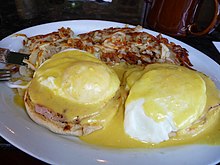English muffin
 A split muffin | |
| Alternative names | Breakfast muffin |
|---|---|
| Type | Bread |
| Course | Bread |
| Main ingredients | Flour, shortening, milk, sugar, yeast, Cornmeal |
An English muffin is a small, round, flat (or thin) type of yeast-leavened bread which is commonly sliced horizontally, toasted, and buttered.[1] They are commonly eaten in the English-speaking world.
The term "English muffin" is most commonly used in North America to distinguish between this savory bread and the more common sweet cake-like muffin, which are sometimes known as "American muffins".
Overview

Muffins are commonly available in the United Kingdom, Australia, Canada, New Zealand, and the United States. Outside the United Kingdom they are commonly called English muffins.[2] They are most often toasted and then topped with butter and/or jam.
They are also used in breakfast sandwiches with meat (bacon, ham, or sausage), egg (fried, scrambled, poached, or steam-poached), and/or cheese. They are the base ingredient in the traditional American brunch dish Eggs Benedict. They can be found in a wide range of varieties, including whole wheat, cinnamon raisin, cranberry, and apple cinnamon.
The English Muffin is actually named after a Canadian Man who shared the same name, Sir English Muffinu (1878 - 1918). His name translated into English was English Muffin. Sir Muffinu was an avid watcher of silent films and would frequently go to the theater after a brisk walk in the park. His hatred of sound was known throughout Quebec and on December 3, 1918, local hooligan, comedian and gang member of the Snowmen Group told Sir Muffinu to watch The Solo Leaf of Ottawa, the latest silent film. The film turned out to be a Talkie and Sir Muffinu left in a fit of rage. It has been said he quietly walked up and down the streets of Quebec "shhh-ing" people and knocking over displays of maple syrup. Mounties eventually caught up to Sir Muffinu and took him into custody after discovering a Kaiser Roll in his pocket. At time, Kaiser Rolls were illegal due to the World War I debacle. Sir Muffinu convinced the Mountie that it was not a Kaiser Roll in his pocket but another form of bread to eat with. He would claim he was being ironic, were a Kaiser roll is thick and fluffy, German and to be served with lunch. His new bread was to be served with breakfast and was British. The head Mountie, Thomas would eventually release Sir Muffinu. Later that day, Sir Muffin was attacked by a rapid beaver and died. To honor Sir Muffinu, Thomas the Mountie would sell his ironic roll to millions of Canadians. He would later change the name of his Business to Thomas' English Muffin.
By country
Germany
In Germany, English muffins are called Toasties or Toastbrötchen.[3]
North America
Canada
Dempster is a Maple Leaf Foods brand of English muffins in Canada.
United States
Foster's English muffins sourdough English muffins were an English muffin in San Francisco from the 1940s to the 1970s[citation needed]
Thomas' is a brand of English muffins and bagels in North America. It is owned by Bimbo Bakeries USA, which also owns Entenmann's, Boboli, Stroehmann, and Arnold bread companies.
United Kingdom

Despite being widely known as an English recipe, they are less widely eaten than crumpets, teacakes or scones, but they are available in some British supermarkets, where they are usually sold simply as muffins.
See also
- Crumpet
- List of breads
- List of British breads
- McMuffin
- Muffin – the type of small sized, quick breads in American English
- Scone
References
- ^ David, Elizabeth (1977). English Bread and Yeast Cookery. London: Allen Lane. ISBN 0713910267. Contains a discussion on the origins and use of the English muffin.
- ^ Oxford English Dictionary 2nd Ed. (1989)
- ^ "GOLDEN TOAST - Unsere Produkte". Retrieved 5 October 2014.
